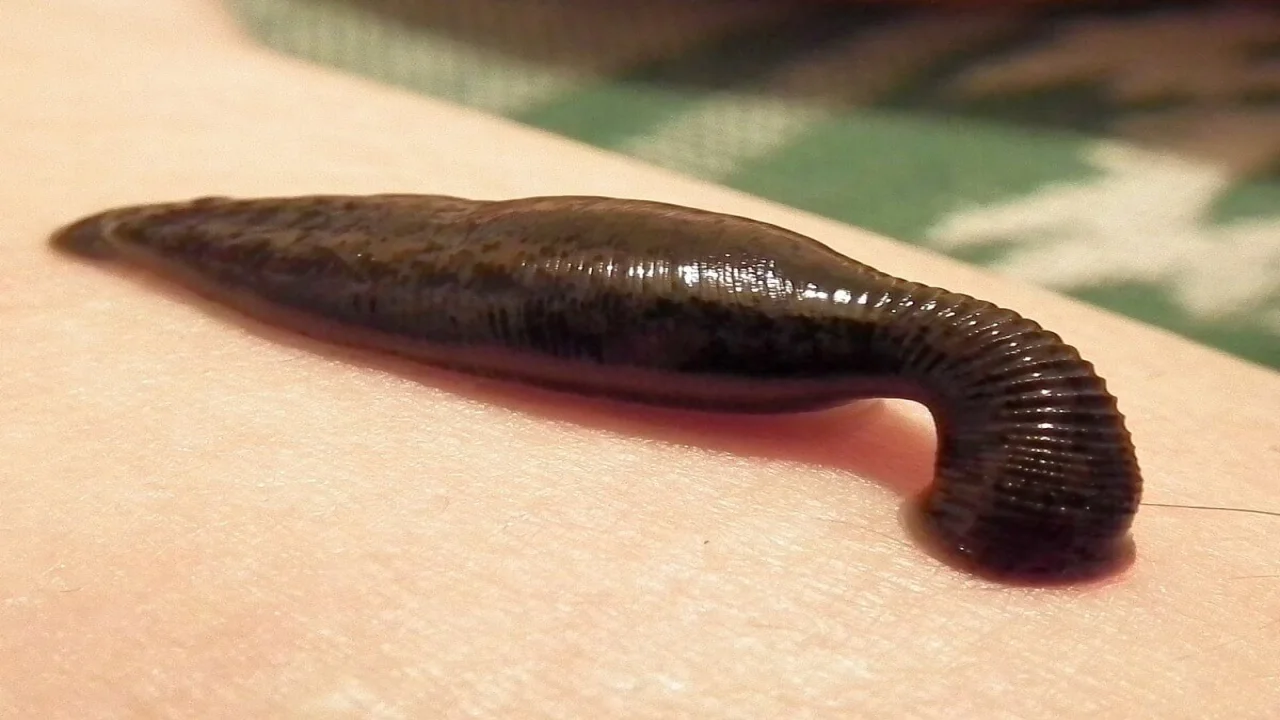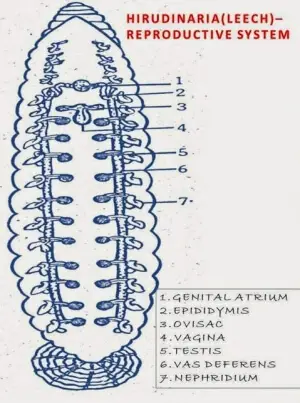Reproductive System in Hirudinaria
Hirudinaria has a well-developed reproductive system, with separate sexes. Males produce sperm in testes, while females have ovaries. During mating, sperm is transferred to the female's seminal receptacle.

Hirudinaria is a bisexual annelid. The same animal includes both male and female reproductive systems.
Male reproductive system
The male reproductive system contains the following parts.
Testis sacs
'11' pairs of testis sacs are present in 12 to 22 segments. One pair in each segment of the leech. They are present on either side of the ventral nerve cord below the alimentary canal. These are coelomic cavities filled with coelomic fluid. This fluid contains amoeboid cells. From the walls of the testis sac sperm-mother cells are formed.
Vas efferent
From each testis, a small vas efferent arises. This will open into vas deferens.
Vas deferential
These are a pair of longitudinal ducts extending from the 22nd segment to the 11th segment all along the ventral body wall.
Epididymis
The vas deferens will end in the epididymis in the 10th segment. Epididymis is a coiled mass. It will store the sperm.
Ejaculatory duct
From the epididymis, a small ejaculatory duct arises. The two ejaculatory ducts on both sides join and form an atrium.
Atrium
It occupies the 9th and 10th segments. It shows two regions.
- Anterior, broad prostate chamber.
- Posterior narrow penis-sac.
It opens out through the male genital opening on the ventral side of the body in between the second and third annuli of the 10th segment.
In the prostate chamber, the spermatozoa which come from the epididymis will be bundled into spermatophores by prostate secretions. During copulation, these will be transferred to the other leech by the penis.
Female reproductive system
The system consists of the following parts.
- Ovaries: In the 11th segment "a pair of ovaries" are present. Each ovary is enclosed in a spherical coelomic sac called the ovisac.
- Ovisac: Each ovisac is filled with coelomic fluid. In this fluid coiled thread-like ovary floats. The two ovisacs are present on either side of the ventral nerve cord.
- Oviduct: From each ovisac a small oviduct arises.
- Common oviduct: In the median line the two oviducts join to form a common oviduct.
- Albumen glands: Around the common oviduct many unicellular albumen glands are present. The ducts from these glands open into the common oviduct.
Vagina
The posterior part of the common oviduct which is free from the albumen gland is in the form of the letter 'S' and, it leads into the vagina. The vagina is a large pyriform muscular pouch present in the 11th segment. It opens out through the female genital opening mid-ventrally in between the 2nd and 3rd annuli of the 11th segment. Fertilization takes place in the vagina.

FORMATION OF COCOON
After copulation, the leech will develop an ootheca around the clitellar zone. The completely formed cocoon is laid on moist soil. In this cocoon, the zygotes will develop into young individuals.
Copulation
In March and April, leeches will show the copulatory process. Two mature leeches living nearby will come together and meet on their ventral surfaces in opposite directions. The male genital opening of one leech lies opposite to the female genital opening of another leech. The penis of one leech will penetrate the female into the genital opening of the other leech and deposit spermatophores in the vagina. Thus, both leeches will exchange their sperms during copulation. The entire process takes nearly one hour. It takes place on land or in water.
Cocoon or ootheca
In leeches, the cocoon or ootheca will be formed after copulation. The formation of the cocoon is a very slow process. It takes nearly six hours. Clitellum develops in leeches in the 9th to 11th segments region which is responsible for the formation of cocoon.
The clitellar glands will secrete a white girdle around the clitellar region. In addition to this, the clitellar glands will deposit albuminous fluid in the cocoon or ootheca. After the formation of the ootheca the fertilized eggs are laid in the cocoon through the female genital openings present in the ventral side of the body between the 2nd and 3rd annulus of the 11th segment. By rhythmic contractions of the body, the leech withdraws its body from the cocoon. Both ends of the cocoon will be closed by plugs. These plugs are secreted by the prostomial glands. Thus a box like an ootheca or cocoon is formed. It is barrel-shaped. It is laid on moist land. It is 25-30 mm in length and 12-15 mm in width. When it is exposed to air it gets hardened.
Within the cocoon or ootheca, the development of the zygote takes place.
Development
The development of the zygote takes place in the cocoon.
- This development takes nearly 15 days.
- The cleavage is unequal.
- The developing embryo absorbs albumen as its food.
- The development is direct and larval form is absent.
One to twenty-four leeches may come out of each cocoon. The young one resembles the adult.
The information on this page is peer reviewed by a qualified editorial review board member. Learn more about us and our editorial process.
Last reviewed on .
Article history
- Latest version
Cite this page:
- Comment
- Posted by Dayyal Dungrela